X
This article was medically reviewed by Shaune Wallace, OD. Dr. Wallace is an Optometrist in Nevada with over 14 years of optometry experience. He received his OD from the Southern California College of Optometry in 2006 and is a member of the American Optometric Association.
This article has been viewed 37,714 times.
A monocular is like a small telescope. It is smaller and lighter than binoculars while packing the same power. To use a monocular, make sure that you keep a firm and proper grip on it while holding it up to your eye. You will localize and track your target through the lens. To ensure that you get the most of your monocular, keep it safe and clean during use.
Steps
Method 1
Method 1 of 3:
Looking Through the Monocular
-
1Use your dominant eye. If you have impaired vision, it is important to use the eye with the best vision. This can be helpful even if you have normal vision. Hold the monocular up against this eye while using. Be sure to hold the monocular with the hand on the same side as the dominant eye.[1]
- If you are unsure which eye is dominant, you can do several tests to find out. Read How to Determine Your Dominant Eye to learn more.
-
2Wear your glasses. If you wear glasses to see, you will want to wear them while using the monocular. Let the monocular press lightly against your glasses. You may want to fold down the rubber end to help aid your field of view.
- If you wear glasses, you will want to choose a monocular that offers at least 14mm of eye relief. This means that you can hold the monocular at least 14mm away from your eye and still see through it. The eye relief of your monocular will be clearly stated on the box of your monocular or on the manufacturer's website.[2]
Advertisement -
3Hold the monocular up to your eye. Raise the monocular to your eye while gripping the barrel close to the ocular lens (the lens near your eye).[3] The lens should be as close to the eye as possible without actually touching it. Close the other eye to maintain focus, and steady the monocular by resting your forefinger against your brow. Keep your elbow against your body to help keep the arm still.
- You can also steady the monocular by holding your wrist still with your other hand.
- Another way to get a stable view is to lay on your stomach and rest your elbows on the ground, providing a stable anchor for the lens.
- Do not touch either of the lenses on the scope.
-
4Adjust the focus. Different types of monoculars are adjusted different ways. Some monoculars can be adjusted with one finger rotating a ridged dial on the monocular. Others require the use of both hands. If the scene is becoming blurrier instead of clearer, rotate the dial in the other direction.
Advertisement
Method 2
Method 2 of 3:
Tracing and Tracking with the Monocular
-
1Face the target. Before you use the monocular, you should locate the object that you want to view. You can position yourself by pointing your nose and toes towards the target.[4] Keeping an eye on this object before you raise the monocular can help you locate it more easily once the monocular is on your eye.
- It can be harder to find and track an object with a monocular vs. binoculars because you don't have the same perception of depth as you would with binoculars.
- It might help to observe other geographic features around the object you want to track, such as a tree branch, rock, or patch of dirt. Using these markers can help you focus on the right area and find your way to your intended target.[5]
- If you lose sight of the object when you place the monocular to your eye, try opening your other eye to try to point the monocular in the right direction.
-
2Turn your head to track the target. If you are observing a moving target, you will have to follow this target with your sight. Turn your head slowly to follow it. If your target moves a great distance, you may slowly move your body as well. The monocular does not move from your eye.
- Sudden movements can cause you to lose track of your target.
-
3Refocus as targets move. If your target moves closer or farther away, you will have to focus the lens as you go. This will keep the target clear in your view as it moves. Focus the lens as you move your head and body to follow the target.
- You can practice this action by rolling a ball back and forth, and tracking it with the monocular. This will help you learn how to focus the lens quickly and accurately.
-
4Stay still. It is not wise to move with the monocular pressed against your eye. Your magnified vision may cause you to miss objects that are close to you, causing you to trip or injure yourself. Always turn your body to track a moving object, but do not walk, run, paddle, or drive while using the monocular.
Advertisement
Method 3
Method 3 of 3:
Protecting Your Monocular
-
1Use the strap. If your monocular comes with a strap, you should keep it wrapped around your wrist or neck while using it. This will prevent your monocular from dropping and breaking. This is especially important if you are using it while on a boat or around water. If your monocular falls into the water, it can sink.
-
2Keep your monocular dry. While you can buy a waterproof monocular, these are often more expensive. If you are on a boat or kayak, you can protect your monocular by keeping it in a zipped freezer bag while it is not in use. Make sure that it is completely sealed to ensure that water does not get inside.
- You can even double-bag the monocular for even more protection.
-
3Use the lens cap. If your monocular came with a lens cap, make sure you have this in place whenever you are not using the lens. It protects the lens from damage as well as from dust, water, and other debris.
-
4Clean your monocular. If you notice blurred vision or specks obstructing your view, you may have to clean your monocular. You can use an eyeglass wipe to clean off the lens. If there are specks of dirt and sand in the lens, you can use a can of compressed air to blow them off. Toilet paper, tissue, and window cleaners may be too harsh for delicate lenses and may cause scratches.
- Using your t-shirt can leave streaks if your clothing is treated with fabric softener.
Advertisement
Warnings
- Scratches on the lens may permanently alter the vision on your monocular. Keep your monocular in its case after use, and gently remove any debris from the lens.⧼thumbs_response⧽
- Do not touch either lens of the monocular. Fingers can leave smudges on the lens, reducing your vision.⧼thumbs_response⧽
Advertisement
References
- ↑ https://www.youtube.com/watch?v=3O-1h0kskm8&feature=youtu.be&t=83
- ↑ https://www.allaboutbirds.org/news/how-can-i-adjust-my-binoculars-so-i-see-a-good-image-without-blacked-out-areas/
- ↑ https://www.youtube.com/watch?v=3O-1h0kskm8&feature=youtu.be&t=121
- ↑ https://www.youtube.com/watch?v=xN6vRxbEDAE&feature=youtu.be&t=50
- ↑ http://www.birdwatchersdigest.com/bwdsite/explore/optics/how-to-use-binoculars.php
- ↑ https://nerdtechy.com/best-monocular-pocket-scope
About This Article
Advertisement



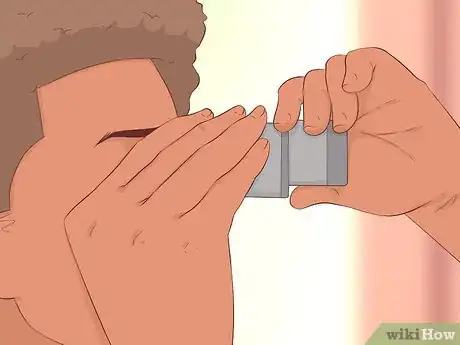
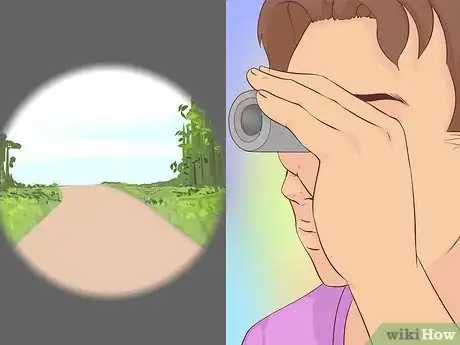
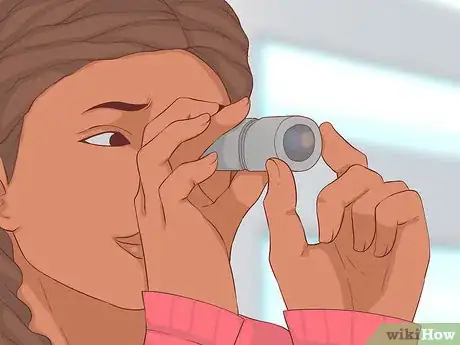

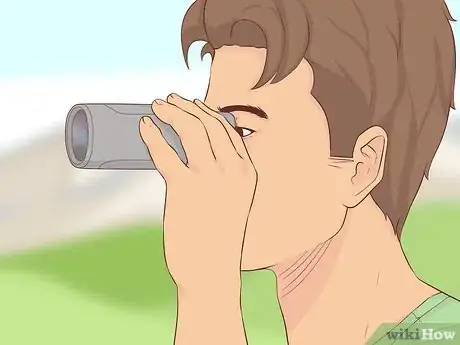
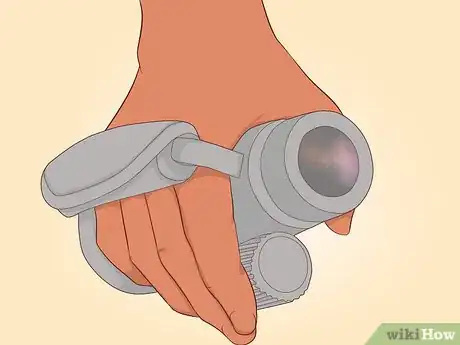
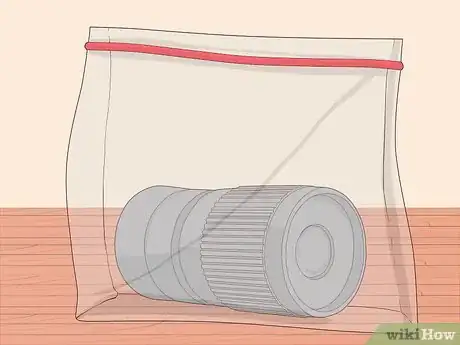
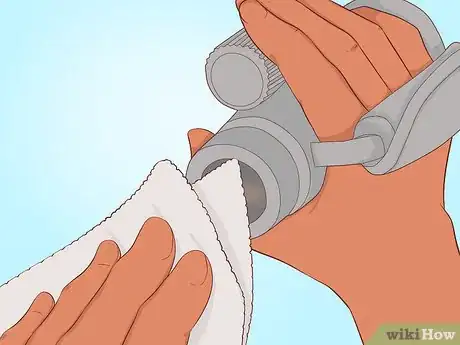

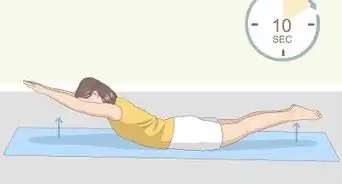



















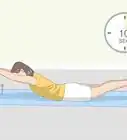





































Medical Disclaimer
The content of this article is not intended to be a substitute for professional medical advice, examination, diagnosis, or treatment. You should always contact your doctor or other qualified healthcare professional before starting, changing, or stopping any kind of health treatment.
Read More...